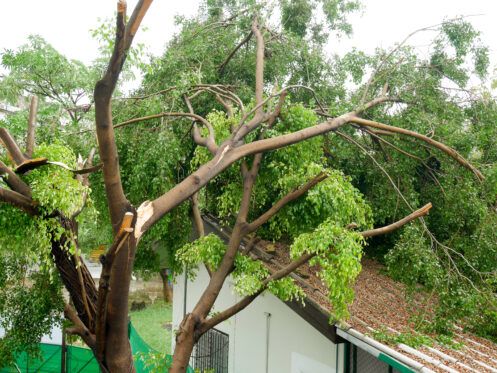For homeowners living in areas prone to storms, it’s crucial to have a strong roof overhead. However, after a big storm, your roof can suffer some damage. While it’s essential to get this damage repaired, in many cases, you can also file an insurance claim. This piece will explore how to assess your roof damage, file a claim, and more.
Damage Assessment
If you suspect roof damage after a storm, assess the damage to see how bad it is. Often, you can do a visual inspection from the ground around your home. For a closer look at your roof, you can use binoculars, a drone (if you have one) or the zoom setting on your smartphone. Take pictures of any signs of damage that you see.
You should avoid going on the roof yourself. Standing on a roof can be dangerous, and if the roof is damaged, it increases the risk of an accident. For a thorough assessment, a roofing company can go up on a ladder and do an in-depth inspection. Professionals will be able to notice subtle damage that you might have trouble spotting.
Minor Damage
Missing shingles are easy to spot. However, also look for shingles that are buckling, curling, or cracked. Dents can appear on shingles after strong hail. If you’re cleaning out the gutters after a storm, you also want to watch for granules or other pieces of roofing material. Examine the flashing. This is the waterproof material that is used to seal the spaces and gaps in your roof. If you notice sagging in any part of your roof, this can indicate structural damage.
Major Damage
Major damage will be clear right away. Storms can blow trees onto your home, crushing your roof. Also, large tree branches can break off of a tree and cause major damage to your roof. Ice damming is when a strong ice ridge forms on the edge of your home’s roof. This makes it difficult for water from the melting snow to properly drain off of your roof. The weight and water build-up can lead to cracks and leaking in your roof. Additionally, a heavy snow load can rip your gutters off of your roof.
If damage is major, you may want to call someone to tarp your roof immediately to avoid water damage. Tarps can be moved for insurance assessments. If the damage makes your home unlivable, check with your insurance company about temporary housing.
Insurance Policies
Not all homeowner’s insurance policies are the same. You must understand your policy well. You need to know what is and isn’t covered. Review the section of your policy that covers roof damage. It’s common for homeowner’s insurance to cover damage due to things like hail, wind, snowload and lightning.
Check what your policy covers and what terms and conditions apply to that coverage. Some policies may not cover damage claims due to maintenance neglect or normal wear over time.
Claim Filing
Once you have established that you have roof damage that’s likely covered by your insurance policy, it’s time to file a claim. You want to file your insurance claim as quickly as possible after a storm. Prompt claim filing will help ensure a smooth process and minimize any possible delays.
The first step is to contact your insurance company and speak with them about the damage. They’ll wan details from you like the date of the storm and any photo or video documentation you have.
In most cases, once you have notified your insurance company of the roof damage, they will send someone to inspect your roof. This can be an adjuster who works directly for them or a third-party inspector. They will assess the damage and determine whether it is covered by your policy.
While waiting for your claim to be considered, stay in contact with your insurance company. Respond to inquiries quickly and provide any additional information that they ask for. As you communicate with your insurance company, track all communication with them. You want to save emails, take notes during phone calls, save letters, and more.
After they have approved your claim, you can hire a roofing contractor that will fix all of the storm damage to your roof. In many cases, you’ll be asked to have a roofing company give an estimate to fix the damage before your claim is approved. The payout of your claim depends on the details of your policy and the condition of your roof before the damage.
While you should take steps to protect your home from any further damage after a storm, avoid making any large repairs to your roof until after your insurance company has approved your claim. Additionally, if you have taken care of your roof with ongoing regular maintenance, you may see a more favorable reimbursement for damage repair costs.
Do you live in the Twin Cities, MN area and need roofing services? Doug Brue Construction offers roof installation, inspections, repairs, and replacements. Additionally, they also have siding, windows, and gutter services. For more information, contact Doug Brue Construction today.







